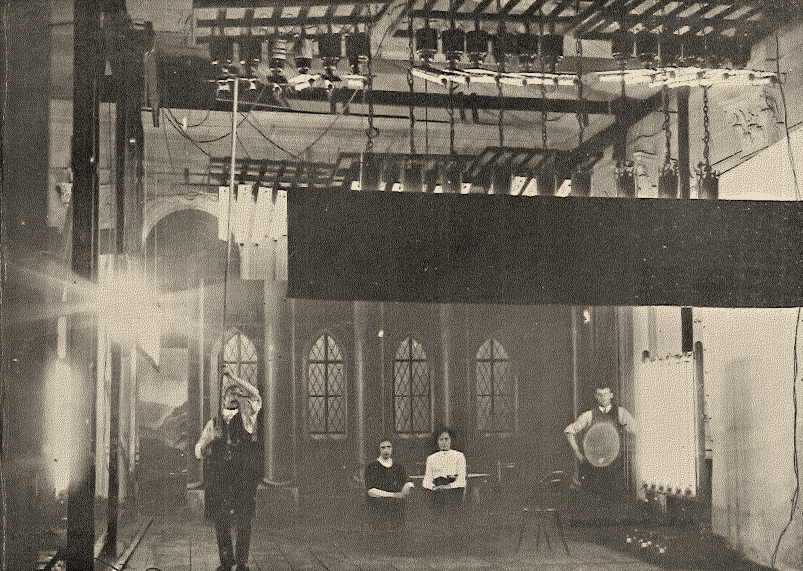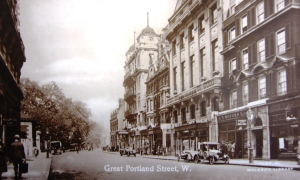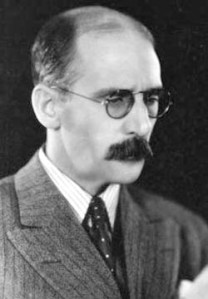I was reading George Pearson’s memoirs, Flashback, again recently because I wanted to know a bit more about the place where he first tried his hand as a film director: a film studio on, or rather underneath, Great Portland Street in central London (pictured above).
For a short while, this underground studio was the British production headquarters of Pathé Frères, who made films there under the brand names of ‘Britannia’ and later ‘Big Ben’, produced by one of Pathé’s subsidiaries, the Union Film Publishing Company (see Luke McKernan’s entry about Pathé on the BFI Screenonline website).
Great Portland Street in the 1910s
The studio seems to have been in action from 1912 to 1914, when the company moved away from the city centre to more spacious premises at Alexandra Palace. Other directors to work there during these years included H. O. Martinek and A. E. Coleby, whom Pearson remembered being taken to meet by Pathé execs in 1912 on the set of Peg Woffington. Pearson himself arrived there at the start of 1913, having left his former career as a schoolmaster. (The local historian Stephen Pewsey mentions that Pearson’s ex-pupils at Staples Road Boys’ School in Loughton were none too happy with his replacement, a strict Welshman named Williams, who found a chalked message waiting for him on the school’s brick gate-pillars: ‘We want Pearson back, down with Williams!’)
George Pearson, from britmovie.co.uk
Pearson described the studio when he got there as ‘a curious little place’, lit entirely by mercury-vapour tubes, under which ‘everyone looked as though suffering from acute heart disease’. The single camera was ‘mounted on a heavy capstan-head bolted rigidly to the floor’, so that the camera angle was always the same in every shot. Pearson took the camera off its mount and played around with close-ups. Given the experimentation that seems to have been going on under Pearson’s watch, it would be great if more of his early films survived.
Patricia Warren’s encyclopedic history of British film studios mentions the Union Film Publishing Company premises, but doesn’t give an exact location. So the challenge I set myself – as yet unfulfilled – was to find whereabouts on Great Portland Street this studio was situated. Sadly, Pearson doesn’t say, and, so far, Post Office directories, Ordnance Survey maps and fire insurance plans have yet to yield up a street address either (if you know any details, I’d love to hear from you).
A view looking south down Great Portland Street
But Pearson’s memoirs more than make up for this small omission. In fact, there’s one episode in Flashback that’s so surreal, it’s worth quoting at length:
we wanted a shot of a mounted huntsman about to ride from his country mansion, a painted and imposing doorway on a huge canvas drop-scene suspended from the ceiling. With great caution and wary pushes we had propelled a perplexed horse along a slippery stone passage that gave him no sure foothold, and gently urged him along much as an ocean liner is edged into harbour by little tugs. We got him at last on to the wooden stage floor, and into position by the ornate door, midway between the unlit mercury-light banks to his head and rear. The actor huntsman was hoisted into the saddle, and was all for the ‘take’, or as it happened, the ‘kill’, for when the signal for lights was given, and the light banks suddenly flashed on, that utterly bewildered horse saw red! He made one wild dash, and we were all mixed up with crashing mercury tubes, flying hooves, and the complete collapse of the country mansion, in the ruins of which the huntsmen was buried and lost to sight. We found the amazed horse seated on his hindquarters amid the debris of the painters’ pots and pans, probably wondering what was going to happen next! Truly they were the great days of adventure.
Pearson’s memoirs are published as Flashback: The Autobiography of a British Film-maker (London: Allen & Unwin, 1957). The book by Patricia Warren mentioned is British Film Studios: An Illustrated History (London: Batsford, 2001). The local history newsletter with Stephen Pewsey’s article, ‘George Pearson in Loughton’, is available online as a pdf.




